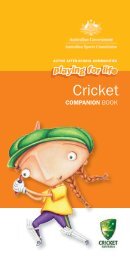Cricket
You also want an ePaper? Increase the reach of your titles
YUMPU automatically turns print PDFs into web optimized ePapers that Google loves.
UNIT 3<br />
Tactics and Field Placement<br />
25<br />
It has not been possible to cover these topics in any detail, and again<br />
teachers are referred to more comprehensive texts.<br />
In terms of tactics this section has been sub-divided into key points for<br />
consideration when examining the tactics of the game from the<br />
perspective of the bowler and the batsman.<br />
THE BOWLER<br />
Tactics for Seam Bowlers<br />
Bowl at the wicket or just outside off stump.<br />
When attempting to swing the ball, aim to pitch the ball close to the<br />
batsman to encourage front foot strokes, i.e. bowl a full length.<br />
Vary length from time to time so that batsman has to think whether to<br />
play forward or back. Bowl the occasional bouncer.<br />
Encourage dangerous strokes by leaving gaps in the field and pitching the<br />
ball so that it is difficult to hit the ball into those gaps.<br />
Frustrate batsman by bowling to avoid his favourite strokes, e.g. keep<br />
front foot players on the back foot by bowling shorter length balls.<br />
Do not bowl too many variations, e.g. outswinger, inswinger, off cutter,<br />
leg cutter. It is difficult to set fields for a great variety of balls. Do vary<br />
your position on the crease.<br />
If one batsman is poor try to bowl at him most of the time by allowing the<br />
better batsman the opportunity of scoring singles early in the over by<br />
setting the field deeper.<br />
Towards the end of an over do not allow the better batsman a single so<br />
that he faces the next over. Bring the field in to stop the single.<br />
Tactics for Spin Bowlers<br />
Much of the previous section on tactics for seam bowlers applies to spin<br />
bowlers with the addition of the following:<br />
It is essential to bowl a good or even fuller length.<br />
Always try to spin the ball even if the pitch appears unresponsive.<br />
Use the variations sparingly, e.g. floater, arm ball, etc.<br />
Vary pace and flight, i.e. release ball earlier to give a high trajectory and<br />
later to give a low trajectory.<br />
Use width of crease and change from round the wicket to over wicket or<br />
vice versa if necessary.<br />
Adjust field to attack defensive batsman and set field to cut off runs for an<br />
attacking batsman.<br />
If not successful at one end ask to bowl from the other.<br />
THE BATSMAN<br />
Tactics for Batsmen<br />
Batting in cricket not only involves high levels of physical skill, but also<br />
judgemental and decision making skills. The batsman has to make<br />
decisions regarding his reaction to the tactics of the opposition. The<br />
speed of this decision making will be dictated externally, i.e. externally<br />
paced, or influenced by the speed and accuracy of the bowler, the field<br />
placement of the opposition, the stage in the innings, and the stage in the<br />
match. Often players have to make decisions based on anticipated<br />
outcomes. In other words, the speed of the ball will be too fast for the<br />
human visual system to track, and therefore a player must predict what<br />
will happen and base his/her decision on this judgement. At school level<br />
the task is easier in terms of the speed of bowlers, but difficult in terms of<br />
the batsman’s experience. The following should act as basic guidelines.




